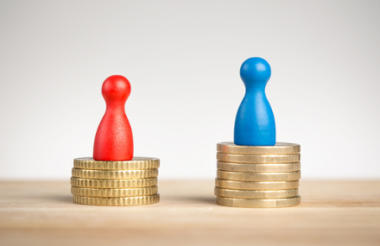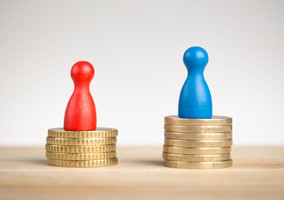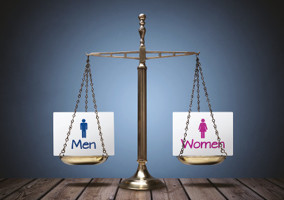The average gender pay gaps at a sample of 100 of the largest charities in the UK have narrowed, according to research from Civil Society.
In April 2022, the average mean gender pay gap last year was 9.8% in favour of men, compared to 10.2% the year before.
Meanwhile, the average median gender pay gap for the 100 charities surveyed was 7.2%.
Both are lower than the 11.2% gap recorded five years ago and less than the 14.9% average pay gap for all employees in the UK, calculated by the Office for National Statistics (ONS).
Longer term trend
Organisations with more than 250 employees have to submit their annual gender pay gap data to the government by 4 April each year and publish the data on their website. The latest data in this study relates to a snapshot from 5 April 2022.
Civil Society has been tracking the average mean gender pay gap at the same 100 large charities for the past six years.
Before this year’s results, the mean gender pay gap had been gradually narrowing from the 11.2% figure recorded five years ago.
This is the first time Civil Society has analysed the median data from each charity, which is more directly comparable to ONS figures.
Four-fifths (81) of the charities surveyed this year had a median gender pay gap below the ONS national average for 2022.
Out of the 100 charities analysed, the median gender pay gap increased in the year at 39 charities, stayed the same at seven, and decreased at 53. Comparable data was not available for one of the charities surveyed as they failed to provide figures for the previous year.
Highest and lowest median pay gaps
MSI Reproductive Choices, a women’s health charity, had the highest gender pay gap in favour of men in our sample.
With a gender pay gap of 33.3%, women earn 67p for every £1 that men make at the charity on average.
This is an increase on the charity’s 2021 gender pay gap, which sat at 30.3%.
Some 63.8% of men received bonus pay at MSI in 2022 while 36% of women did.
Eton College had the second largest pay gap at 30%, meaning women make 70p for every £1 men do at the organisation.
Women occupied 76% of lower-paid roles at the charity, compared to 40% of higher-paid positions.
This compares to the year before, when 79% of people occupying lower-paid roles were women compared to 33% in the higher-paid positions.
PDSA had the third-highest gender pay gap at 29.7% meaning women earn 70p for every £1 men do.
23 charities had a gender pay gap of 0% or lower.
Fusion Lifestyle, a sports and leisure charity, had the highest median gender pay gap in favour of women at 39%, meaning they earn £1.39 for every £1 that men make. This is a dramatic rise from its 2021 data where the median hourly pay gap was 0%.
The British Museum had a gender pay gap of 9% for 2022 in favour of women, meaning they made £1.09 for every £1 men did. The year before, women's average hourly pay was 10% higher than men’s.
Meanwhile, the Royal Shakespeare Company saw its gender pay gap change from 0.4% in April 2021 to 13.3% in favour of men in its latest data, meaning women now make 87p for every £1 a man makes on average.
More women on average received a bonus
Some 53 of the charities in the study awarded bonus pay to their staff. The remaining 47 did not give bonus pay or did not provide the information.
Of the charities that awarded bonus pay, the average proportion of women employees that received it was 32% while on average 30% of men received bonus pay.
The Royal Society of Chemistry awarded the most bonus pay to its staff, with 92% of women receiving a bonus and 93% of men.
Francis Crick Institute had a median bonus pay gap of 11.5% in favour of women, with 0.5% of women being awarded a bonus compared to 0.1% of men.
RSPCA had one of the largest bonus pay gaps at 261.4%. This means that on average men made £3.61 for every £1 women did in bonuses. RSPCA said this was due to long service awards.
Some 2.6% of women received bonus pay at the organisation compared to 4.2% of men.
More women work in lower-paid jobs
There are more women than men working in the charity sector – 67% of the workforce according to NCVO data – which is reflected in the sample.
But the data shows there are on average a higher proportion of women working in lower-paid roles (quartile one) than in higher-paid, senior positions (quartile four) at charities.
The average proportion of women in lower-paid roles for the 100 large charities in the sample is 69.2%, while the percentage of those in senior positions is 61.4%.
At 22 charities in the sample, men outnumbered women in senior positions.
Islamic Relief Worldwide had the lowest proportion of women in senior roles out of the sample with 19%, compared to 43% in higher-paid roles.
Methodist Homes, the social care charity, had the highest number of women in senior positions with 84.8% and 81.3% in lower-paid roles.
MSI Reproductive Choices had the highest proportion of women in lower-paid roles at 93%, while 68% of people in higher-paid roles were women.
The charity with the lowest proportion of women in the lowest pay quartile was Elim Foursquare Gospel Alliance at 20%, but only 21% of its higher-paid workers were women as well.
Editor's note: This article's headline and contents have been updated to reflect revised figures.











